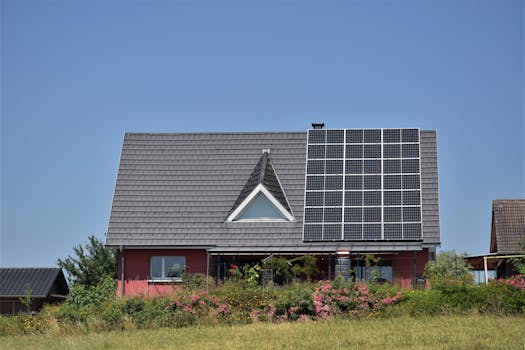“Empowering Tomorrow: Unleashing the Future of Solar Inverter Technology in 2024!”
In 2024, solar inverter technology is witnessing significant advancements aimed at enhancing efficiency, reliability, and integration with smart grid systems. Key innovations include the development of more efficient multi-level inverters that reduce energy losses, improved energy storage solutions that facilitate better management of solar energy, and the integration of artificial intelligence for predictive maintenance and performance optimization. Additionally, the rise of bi-directional inverters is enabling seamless energy flow between solar systems and electric vehicles, promoting greater energy independence. Enhanced safety features and compliance with evolving regulatory standards are also shaping the landscape, making solar inverters more user-friendly and accessible for residential and commercial applications.
Advances in Solar Inverter Efficiency
As we move into 2024, the solar energy sector continues to witness remarkable advancements, particularly in solar inverter technology. Solar inverters play a crucial role in converting the direct current (DC) generated by solar panels into alternating current (AC), which is essential for powering homes and businesses. The efficiency of these inverters directly impacts the overall performance of solar energy systems, making innovations in this area particularly significant. This year, several key developments are enhancing inverter efficiency, thereby maximizing energy output and reducing costs for consumers.
One of the most notable advancements in solar inverter technology is the introduction of multi-level inverter designs. These innovative systems utilize multiple voltage levels to improve the quality of the output waveform, which in turn reduces harmonic distortion. By minimizing losses during the conversion process, multi-level inverters can achieve efficiency ratings exceeding 98%. This improvement not only enhances the performance of solar installations but also extends the lifespan of the inverter itself, as reduced heat generation leads to less wear and tear on components.
In addition to multi-level designs, the integration of artificial intelligence (AI) and machine learning into inverter technology is revolutionizing how these devices operate. Smart inverters equipped with AI algorithms can analyze real-time data from solar panels and adjust their performance accordingly. This capability allows for optimal energy harvesting, as the inverter can dynamically respond to changing environmental conditions, such as shading or temperature fluctuations. Consequently, these intelligent systems can significantly increase energy yield, ensuring that solar installations operate at peak efficiency throughout the day.
Moreover, advancements in materials science are contributing to improved inverter efficiency. The development of wide-bandgap semiconductors, such as silicon carbide (SiC) and gallium nitride (GaN), is particularly noteworthy. These materials exhibit superior electrical properties compared to traditional silicon, allowing for higher switching frequencies and reduced energy losses. As a result, inverters utilizing wide-bandgap technology can achieve greater efficiency while also being more compact and lightweight. This shift not only enhances performance but also simplifies installation and reduces the overall footprint of solar energy systems.
Another trend gaining traction in 2024 is the push towards modular inverter designs. Modular inverters allow for scalability, enabling users to expand their solar systems incrementally. This flexibility is particularly appealing for residential and commercial applications, where energy needs may evolve over time. By employing modular designs, users can optimize their systems for efficiency, as each module can be independently monitored and managed. This approach not only enhances overall system performance but also facilitates easier maintenance and upgrades.
Furthermore, the growing emphasis on grid resilience and energy independence is driving innovations in inverter technology. Inverters are increasingly being designed with advanced grid-support features, such as frequency and voltage ride-through capabilities. These features enable solar systems to remain operational during grid disturbances, thereby contributing to a more stable and reliable energy supply. As more consumers seek to harness solar energy as a primary power source, the ability of inverters to support grid stability becomes increasingly vital.
In conclusion, the advancements in solar inverter efficiency in 2024 reflect a concerted effort to enhance the performance and reliability of solar energy systems. With innovations such as multi-level designs, AI integration, wide-bandgap semiconductors, modular configurations, and enhanced grid-support features, the future of solar inverter technology looks promising. As these developments continue to unfold, they will undoubtedly play a pivotal role in driving the adoption of solar energy, making it a more viable and efficient option for consumers worldwide.
Integration of Smart Technology in Solar Inverters
As we move into 2024, the integration of smart technology in solar inverters is revolutionizing the way we harness and manage solar energy. This evolution is not merely a trend; it represents a significant leap forward in efficiency, reliability, and user experience. At the heart of this transformation is the incorporation of advanced communication protocols and artificial intelligence, which enable solar inverters to operate more intelligently and responsively than ever before.
One of the most notable advancements in smart solar inverters is their ability to communicate seamlessly with other devices within a smart home ecosystem. This integration allows homeowners to monitor and control their solar energy systems through mobile applications, providing real-time data on energy production, consumption, and storage. By leveraging the Internet of Things (IoT), these inverters can send alerts and notifications, helping users optimize their energy usage and reduce costs. For instance, if energy production dips due to cloud cover, the system can automatically adjust the home’s energy consumption patterns, prioritizing essential appliances and minimizing waste.
Moreover, the use of machine learning algorithms in solar inverters is enhancing their operational efficiency. These algorithms analyze historical performance data and environmental conditions to predict energy production and consumption patterns. As a result, the inverter can make informed decisions about when to store energy in batteries or when to draw from the grid, ensuring that homeowners maximize their solar investment. This predictive capability not only improves energy management but also contributes to grid stability, as smart inverters can respond dynamically to fluctuations in demand and supply.
In addition to improving efficiency, smart technology in solar inverters is also enhancing safety features. Modern inverters are equipped with advanced monitoring systems that can detect anomalies or faults in the solar array or electrical system. When an issue is identified, the inverter can automatically disconnect from the grid, preventing potential hazards such as electrical fires or equipment damage. This proactive approach to safety is crucial, especially as more households adopt solar energy solutions.
Furthermore, the integration of smart technology is facilitating better energy storage solutions. With the rise of battery storage systems, solar inverters are now designed to work in tandem with these technologies, allowing for greater flexibility in energy management. Homeowners can store excess energy generated during peak sunlight hours and use it during periods of high demand or when solar production is low. This capability not only enhances energy independence but also contributes to a more resilient energy grid.
As we look ahead, the role of smart technology in solar inverters is expected to expand even further. Innovations such as blockchain technology may soon be integrated into solar energy systems, enabling peer-to-peer energy trading among consumers. This would allow homeowners to sell excess energy back to the grid or directly to neighbors, creating a more decentralized and efficient energy market.
In conclusion, the integration of smart technology in solar inverters is reshaping the landscape of solar energy in 2024. With enhanced communication capabilities, machine learning algorithms, improved safety features, and better energy storage solutions, these advanced inverters are not only making solar energy more accessible but also more efficient and reliable. As technology continues to evolve, we can anticipate even greater advancements that will further empower consumers and contribute to a sustainable energy future. The future of solar energy is bright, and smart inverters are at the forefront of this exciting transformation.
Emerging Trends in Energy Storage Solutions
As we move into 2024, the landscape of energy storage solutions is evolving rapidly, driven by advancements in technology and an increasing demand for sustainable energy sources. One of the most significant trends is the integration of solar inverter technology with energy storage systems, which is reshaping how we harness and utilize solar power. This integration not only enhances the efficiency of solar energy systems but also provides a more reliable and flexible energy supply, catering to the needs of both residential and commercial users.
One of the emerging trends in energy storage solutions is the development of hybrid inverters. These devices combine the functionalities of traditional solar inverters with battery management systems, allowing for seamless energy flow between solar panels, batteries, and the grid. This innovation enables users to store excess energy generated during peak sunlight hours and utilize it during periods of low generation or high demand. As a result, homeowners and businesses can achieve greater energy independence and reduce their reliance on the grid, which is particularly beneficial in regions prone to power outages or fluctuating energy prices.
Moreover, advancements in battery technology are playing a crucial role in enhancing energy storage solutions. Lithium-ion batteries have long been the standard for energy storage, but new chemistries, such as solid-state batteries and flow batteries, are gaining traction. Solid-state batteries, for instance, offer higher energy densities and improved safety features compared to their lithium-ion counterparts. This shift not only promises longer-lasting energy storage but also addresses concerns related to thermal runaway and battery degradation. As these technologies mature, they are expected to become more cost-effective, making energy storage solutions accessible to a broader audience.
In addition to technological advancements, the growing emphasis on sustainability is driving the development of eco-friendly energy storage solutions. Manufacturers are increasingly focusing on using recyclable materials and reducing the environmental impact of battery production. For instance, companies are exploring the use of sodium-ion batteries, which utilize abundant and non-toxic materials, presenting a more sustainable alternative to lithium-ion technology. This trend aligns with the global push for greener energy solutions and reflects a broader commitment to reducing carbon footprints across the energy sector.
Furthermore, the rise of smart energy management systems is transforming how energy storage solutions are utilized. These systems leverage artificial intelligence and machine learning to optimize energy consumption and storage based on real-time data. By analyzing usage patterns and predicting energy needs, smart systems can automatically adjust the flow of energy between solar panels, batteries, and the grid, ensuring that users maximize their energy savings. This level of automation not only enhances efficiency but also simplifies the management of energy resources, making it easier for users to engage with their energy consumption actively.
As we look ahead, the convergence of solar inverter technology and energy storage solutions is set to redefine the energy landscape. With hybrid inverters, advanced battery technologies, sustainable practices, and smart energy management systems on the rise, the future of energy storage appears promising. These innovations not only enhance the reliability and efficiency of solar energy systems but also empower users to take control of their energy consumption. As these trends continue to develop, they will play a pivotal role in the transition towards a more sustainable and resilient energy future, ultimately contributing to a cleaner planet for generations to come.
Impact of Regulatory Changes on Solar Inverter Development
As we move into 2024, the landscape of solar inverter technology is being significantly shaped by a series of regulatory changes that are influencing both the design and deployment of these critical components in solar energy systems. These regulations, often driven by a global push for cleaner energy and enhanced grid stability, are prompting manufacturers to innovate and adapt their products to meet new standards. Consequently, the impact of these regulatory changes is profound, affecting everything from efficiency ratings to safety protocols.
One of the most notable regulatory shifts has been the introduction of stricter efficiency standards. Governments around the world are increasingly recognizing the importance of maximizing energy output from solar installations. In response, many countries have implemented regulations that require solar inverters to achieve higher efficiency levels. This has led manufacturers to invest in research and development, resulting in the emergence of advanced inverter technologies that not only meet but often exceed these new benchmarks. For instance, the integration of artificial intelligence and machine learning algorithms into inverter systems is becoming more common, allowing for real-time optimization of energy conversion processes. This not only enhances efficiency but also contributes to the overall reliability of solar energy systems.
In addition to efficiency standards, safety regulations are also evolving. The rise in solar installations has necessitated a reevaluation of safety protocols to protect both consumers and the grid. New regulations are focusing on the need for inverters to incorporate advanced safety features, such as rapid shutdown capabilities and improved fault detection mechanisms. These enhancements are crucial for ensuring that solar systems can operate safely in various conditions, particularly during emergencies or grid disturbances. As a result, manufacturers are prioritizing the development of inverters that not only comply with these regulations but also provide peace of mind to users.
Moreover, the regulatory landscape is increasingly emphasizing the importance of grid compatibility. As more renewable energy sources are integrated into existing power grids, the need for inverters that can seamlessly interact with grid management systems has become paramount. New regulations are pushing for inverters to support advanced grid functionalities, such as demand response and frequency regulation. This shift is encouraging manufacturers to design inverters that are not only capable of generating power but also of actively participating in grid management. Consequently, we are witnessing the rise of smart inverters that can communicate with the grid, adjust their output based on real-time conditions, and contribute to overall grid stability.
Furthermore, the regulatory focus on sustainability is driving the development of environmentally friendly inverter technologies. As governments set ambitious targets for reducing carbon emissions, there is a growing demand for inverters that are not only efficient but also made from sustainable materials. This has led to innovations in the manufacturing processes of inverters, with companies exploring ways to reduce waste and utilize recyclable components. Such initiatives not only align with regulatory requirements but also resonate with environmentally conscious consumers, further propelling the market for sustainable solar technologies.
In conclusion, the impact of regulatory changes on solar inverter development in 2024 is multifaceted, driving advancements in efficiency, safety, grid compatibility, and sustainability. As manufacturers respond to these evolving regulations, the solar inverter market is poised for significant transformation, ultimately leading to more reliable and efficient solar energy systems. This dynamic interplay between regulation and innovation underscores the critical role that policy plays in shaping the future of renewable energy technologies, ensuring that they meet the demands of a rapidly changing energy landscape.
Q&A
1. **Question:** What advancements in efficiency are expected in solar inverters in 2024?
**Answer:** In 2024, solar inverters are expected to achieve efficiencies exceeding 99%, thanks to improved semiconductor materials and advanced cooling technologies.
2. **Question:** How is energy storage integration evolving in solar inverters for 2024?
**Answer:** Solar inverters in 2024 are increasingly integrating with energy storage systems, allowing for seamless management of solar energy and battery storage, enhancing grid stability and self-consumption.
3. **Question:** What role does artificial intelligence play in solar inverter technology in 2024?
**Answer:** In 2024, artificial intelligence is being utilized in solar inverters for predictive maintenance, optimizing energy output, and improving system performance through real-time data analysis.
4. **Question:** Are there any new safety features in solar inverters for 2024?
**Answer:** Yes, 2024 solar inverters are incorporating advanced safety features such as arc detection, rapid shutdown capabilities, and enhanced surge protection to ensure compliance with updated safety standards.
Conclusion
In 2024, solar inverter technology has seen significant advancements, including the integration of artificial intelligence for enhanced energy management, improved efficiency ratings exceeding 99%, and the development of hybrid inverters that seamlessly manage both solar and battery storage systems. Additionally, there is a growing trend towards modular inverter designs, allowing for easier scalability and maintenance. Enhanced communication capabilities, such as IoT connectivity, enable real-time monitoring and optimization of solar energy systems. Overall, these innovations contribute to greater energy efficiency, reliability, and user-friendliness in solar power systems.




